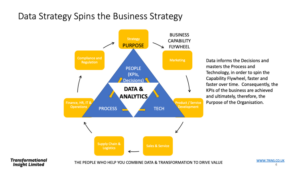Until now, despite many hundreds of articles and case studies in Forbes, HBR there is no manual for how to deliver Sustained and Sustainable performance using Data, Analytics and AI. This is particularly important as we swing into a new wave of Data and AI hype, with Generative AI.
I am now well into my fourth cycle of Data ‘Boom and Bust’ and people keep making the same mistakes so Combining my academic research and 25 years as a Data & Analytics Leader I’ve tried to formulate the basis of a Practitioners Guide.
Let’s be clear Data & Analytics leadership is not about Governance, Architecture, Machine Learning modelling. It is fundamentally a transformational activity, so much so that it might be better to refrain from the term Data & Analytics Leader and instead use the term Chief Transformation Officer.
Why – Data is both the fuel of the business, and the material from which insights are derived to better improve decision making in the business. It is therefore the primary means for improving People, Process and Technology performance in your organisation – in other words Transformation. When your Transformation is ‘done’, you will have reached a state of perpetual evolution and/or adaptation, what I’ve called an ‘Intelligent Business’.
The Intelligent Business
The Intelligent Business is an organisation that utilises predictive and adaptive insight to dynamically reconfigure itself, in response to the expected needs of its customers, and simultaneously anticipate and respond to changes and events in the external environment.
Reaching this Intelligent Business state, requires a Transformational Strategy and Plan. Whilst you will hear a lot about Data Strategies, and Data Transformations, the scope is typically far too narrow and are insufficient to help an entire organisation to transform. What is required is an understanding of what makes your organisation perform, and that requires strategic management theories. Almost all of us have heard of Michael Porters Five Forces, which helps an organisation to develop its competitive strategy.
Having spent 2 years looking at Strategic Management theories as part of my Doctoral research I have focused on two:
- ‘Resource Based Theory’ (RBT), which focuses on the capabilities that businesses and organisations use to create sustained competitive advantage. RBT identifies truly differentiating capabilities if they are Valuable, Rare, Immitable (easy or difficult to copy) and Organisationally embedded (VRIO).
- ‘Dynamic Capabilities’ seem to help explain how organisations can really survive and thrive in the complex and Volatile world we live in where CEOs are not just facing the challenges of AI, but also squaring the circle between Financial Performance and their own and investor needs to deliver ‘sustainable’ (Net Zero) performance.
In the case of Digital, Data, Analytics and AI, we have a fixation on Tools and Technology! The technology is the table stakes, but it is not the source of competitive advantage. If we consider the VRIO of Resource Based Theory, Data technology does not pass the VRIO ‘sniff test’.
- Technology is increasingly one of the biggest tangible assets on many company balance sheets. Technology can be uniquely valuable, and companies can organise themselves to capture the Value (albeit many do not make a success of this). However, whilst Technology can be expensive if you are buying Commercial Off the Shelf Software (CRM, Cloud, ERP, BI etc etc) it is by not costly to Imitate and clearly far from Rare!
- Organisations thinking of spending money on the latest Data Mesh, Data Platforms, Analytics and AI platforms need to fundamentally recognise the fact that the tools themselves may be essential, but by no measure confer a source of Competitive Advantage.
Therefore, combining these two strategic management theories and my 25 years of making organisations perform using Data, Analytics and AI, (borrowing from Stephen Covey) I have developed the Seven Habits of the Highly Effective Data and AI Driven Organisation. Considering these seven habits forms the outline of the Practitioners Guide to delivering the Transformation to an Intelligent Business.
Seven Habits of the Highly Effective Data, Analytics and AI (DAI) Driven Organisation
For me, the first step in this journey in using the VRIO Organisational principle the organisational management and governance of Data & Analytics and AI are in my experience symbiotically connected, and the leaders who bring them together can therefore truly differentiate their businesses. Therefore, combining my research and industry experience I am developing the Seven Habits of Chief Data, Analytics and AI Leader. The Seven Habits are as follows:
- Customers are King (or Queen): Data is central to understanding your customers – what motivates them, what their needs are, and what they are inclined to buy (and for how much). The great companies combine all the data they must predict the needs of their customers and design products and services that meet those future needs. As Steve Jobs famously said, ‘My Customers Will Know What They Want When I Show It To Them!’.Whilst most of us lack the genius of Steve Jobs, when Data Leaders work in partnership with product, marketing and customer stakeholders and identifying the opportunities where Data, Predictive and Prescriptive Analytical Models (Machine Learning and AI) can be deployed to create transformative products and services for Customers. If you think that a leading Grocery Retailer has c.1000 data attributes to tune products and promotions for their customers, but the likes of Amazon and Google have 25,000 (!!) attributes of data about each of their customers. It is therefore critical that you make the collection of data about your customers the central pillar of your journey to an Intelligent Business, your Data Leader and how they can collect, manage, refine and fuel data for your Marketing, Product and Supply Chain will be one of the critical, if not the most critical Value Drivers of your business.Ultimately if we are talking about serving customers you will be talking about Value and contribution to the top and bottom line of the business, something which is scarily absent from the conversations of many Data Leaders, and yet critical to engaging and maintaining the support of the CEO, CFO and other business leader.
- Masters of the External Environment: In addition to collecting great Customer Data, the real advent of ‘big data’ was the need to start to collect and leverage data from outside the organisation including Video, Audio, social media etc. That data can be used to augment an understanding of Customers and in addition central to understanding our external environment, competitors, and suppliers. Those companies that live in highly competitive markets have already had to understand this, they use data and analytics to understand what competitors and new entrants are doing and aim to be at least one step ahead. As markets and environments become more and more volatile, all businesses need to be more agile and data is central to sensing, identifying, and responding to potential external challenges as, and when, if not before they happen! That long history lesson is the precursor to the importance of being Master of the External Environment. In my language in driving insights from the External Environment is the need to understand both ‘strong’ signals and ‘weak signals’.- Strong Signals come from your structured Data Warehouse and the sophisticated analytical techniques they can be exploited with, giving large amounts of data to train Machine Learning models which allow them to develop sophisticated correlations and sometimes actual causation that and will help you with immediate models (as in ‘Customer is King’ – Churn, Propensity, Decisioning!). – Weak Signals come from the external environment. The most obvious ones of late would be the full implementation of Brexit, the Russia/Ukraine conflict, and the COVID-19 Pandemic. These would, if correctly interpreted, have told us in March 2020 and March 2022 that highly curated Machine Learning Models would rapidly start to deliver us horribly inaccurate results.
- Building a Metric (Data) Driven Business Model: I weep when people say they can’t measure the benefits of Data investments… Why, because the discipline of Data & Analytics, includes Business Intelligence and Reporting! In other words, the smart Data Leader is also accountable for providing the key reporting of business performance, so you have the absolute levers at your disposal to measure whether the initiative you’re accountable for has made a difference to the cost, revenue and/or profitability of the business! One critical things people forget is that Data is both an Input and an Output to business processes. Too many companies and their data leaders only focus on the output data and the metrics associated Revenue, Profit, Free Cash Flow etc. These measures are obviously critical, but they only tell you how you have done – they are ‘backward looking’ by Design. The leading businesses look at Input Metrics as well as Output Metrics, after all Data is the fuel of the business and therefore drives the processes that operate the business. Input Metrics could include Page Views, Stock Availability, Price, Discounts, Convenience. To institutionalise this, you need to build an extendable Data Model for your business. The Data model should be built by looking at the Value Drivers of the organisation, which allows the creation of a KPI /Metric Model which gives uninterrupted line of sight between your Level 1 Key Performance/Results Indicators (like Revenue, EBITDA, Free Cash Flow) you report to Shareholders, and the underlying operational metrics of the business (Customer Lifetime Value, Cost of Goods sold, Employee Costs etc etc); as well as those critical Sustainability and ESG metrics. The Data Model can be built around that core performance model and will be owned by your Data Leader. A Data Model will be central to your business operating model and facilitate the migration of your process model into the background.
- Governance and Regulation – your friend not your enemy. Data Governance has been seen as a problem and the enemy of successful Data Leaders, but in my opinion #Risk and #Performance are two sides of the same #Data. If you have a single Data Model, built in partnership with the rest of the business you have the nirvana to manage #risk, #performance and #sustainability. That’s easier said than done, and just understanding the components of Cost, Revenue and Profit in a large business is a substantial undertaking. Building a network of Data Owners and Data Stewards in the business, who will be your arms and legs (and use the data every day, so it’s in their interest for it to be right) is critical and cost effective. Furthermore, central to the privacy laws of most countries is a set of principles that define how personal data are collected, shared and processed. However, consumers often do not know the benefits and costs of the data that pertain to them. Data Leaders need to understand those laws and work closely with Legal/General Counsel (the Data Protection Officer) as well as Marketing, Sales and Finance – typically the data you use to market and sell to a customer is the same a regulator wants to know that you sell and market to a customer and whether you have their consent!
- Migrating to a Data Driven (Micro Services) Architecture in the Cloud: The Intelligent Business operating model is one where Data Serves People and masters Process and Technology. Businesses need to redefine their operating model so they are not limited by the straitjacket of legacy ‘process models’, so that they can embrace a much more Agile approach. Processes will need to be dynamically reconfigured to meet the rapidly changing needs of customers and reconfigure what the business is delivering as Services. Your AI and Machine Learning Algorithms are your source of competitive advantage. MACH (microservices, API-first, cloud-native SaaS, headless) are the design principles behind modern enterprise technology. Built to integrate easily, these technologies are helping companies untangle and step off their legacy tools. With a modular design, MACH solutions give businesses the freedom to choose from the best tools on the market today and provide a structure that makes it easy to add, replace, or remove technologies in the future.Over time we can then migrate away from the ERP, CRM platforms and in their place you need dramatically downsized and become what Technologists call ‘Micro Services’ – at a fraction of the cost. Microservices are an architectural and organizational approach to software development where software is composed of small independent services that communicate over well-defined APIs. Microservices can be developed by your #CTO, a trusted software vendor and/or provided OpenSource. We connect the Data Model to the micro-services with APIs which can be delivered by your #CDAO and #CTO working together and mastered by your integrated Data Model. As you build more, you can pull more and more logic away from those complex monolithic ERP and CRM platforms. The business becomes more agile and data driven by design! As more logic moves into your Data estate, your monolithic business process systems (CRM, ERP, SCM etc) can be dramatically downsized and replaced with ‘Micro Services’ at a fraction of the cost.
- Servant Leadership – Data Serves People. It’s all about people!! And three key communities that need to be addressed. The first community are your (external) Customers (mentioned in principle 1, Customer is King or Queen) – you must be using Data & AI to develop products and services that make a difference to the end customer. The second community is the people within the organisation – the whole concept of the Intelligent Business is to ensure that the Data in your business serves the people in your business to help them make better decisions, which improve service to the end customer and allow the organisation to deliver better revenues, lower costs and improved ESG outcomes. That means upskilling the whole business and developing amongst other things ‘citizen’ data scientists as well as ownership of data amongst the whole employee population. The third population is the Data & Analytics team themselves, and the job of the effective Data Leader is to create, grow and nurture a great team and provide them with exciting work that delivers transformational products and services for the other two populations. Data rarely delivers value in isolation, it’s when it’s combined with other activities that it becomes an enabler, and a multiplier of value creation.
- Data Strategy Spins the Business Strategy: The graphic below talks to this. Many of you will have heard of the ‘FlyWheel’ concept from Jim Collins and his famous business book ‘From Good to Great’. Of those, quite a few will know that Jeff Bezos took that concept, and his strategy was to use input and output KPIs and associated Data and Analytics to spin the fly wheel at Amazon faster than anyone else! with Amazon you need a Data Strategy that spins your Business Strategy.The famous quote of General Omar Bradley is that ‘Strategy is for Amateurs and Professionals discuss logistics!’ The key logistics here is that for a Business Strategy (powered by Data) is that Data is both an Input and an Output. Too many companies only focus on the output data and the metrics associated Revenue, Profit, Free Cash Flow etc. These measures are obviously critical, but they only tell you how you have done – they are ‘backward looking’ by Design. The leading businesses (like Amazon), look at Input Metrics as well as Output Metrics, after all Data is the fuel of the business and therefore drives the processes that operate the business. Input Metrics could include Page Views, Stock Availability, Price, Discounts, Convenience. For those organisations, Data becomes the master of process and technology in your strategy and input (as well as output) metrics are the fuel and instrumentation that drive you forward! How your business (or organisation) chooses to differentiate and deliver sustainable competitive performance, data and analytics capabilities will be a Valuable, Rare, Difficult to Imitate and the Organisation therein will be both key to delivering that Competitive Performance as well as Measuring and Managing it.

The Intelligent Business and the Seven Habits of the Highly Effective Data, Analytics and AI Leader are my first steps towards creating an empirical framework that organisations and leaders can utilise to deliver sustained and sustainable value from Data, Analytics and AI.
Article by channel:
Everything you need to know about Digital Transformation
The best articles, news and events direct to your inbox
Read more articles tagged: AI






